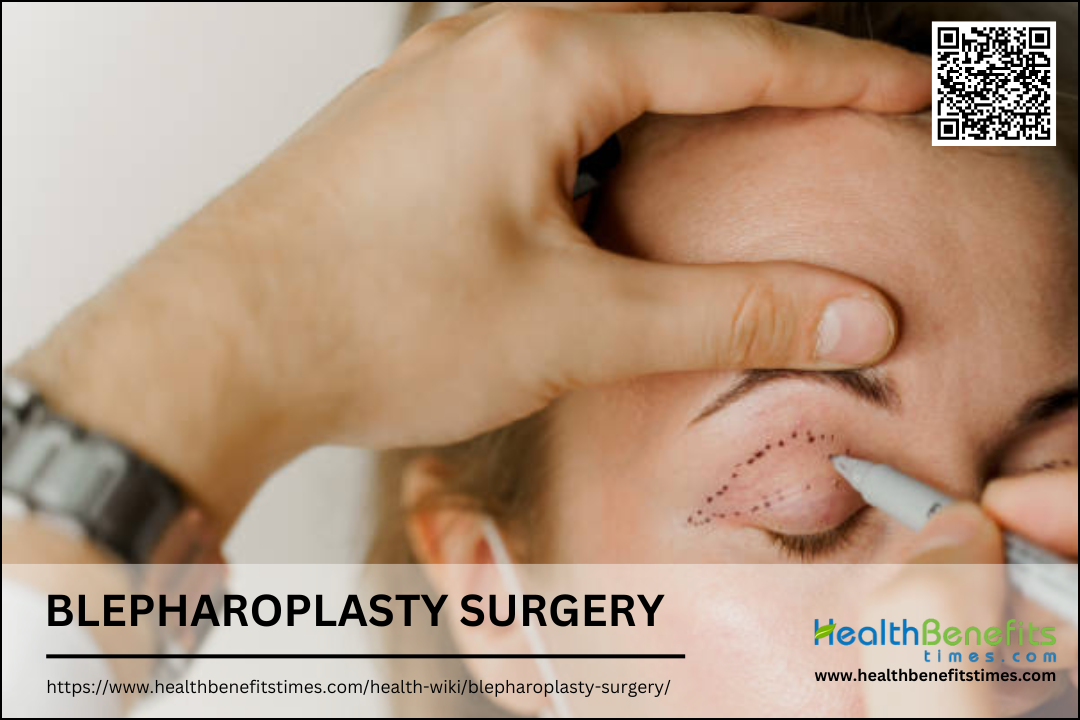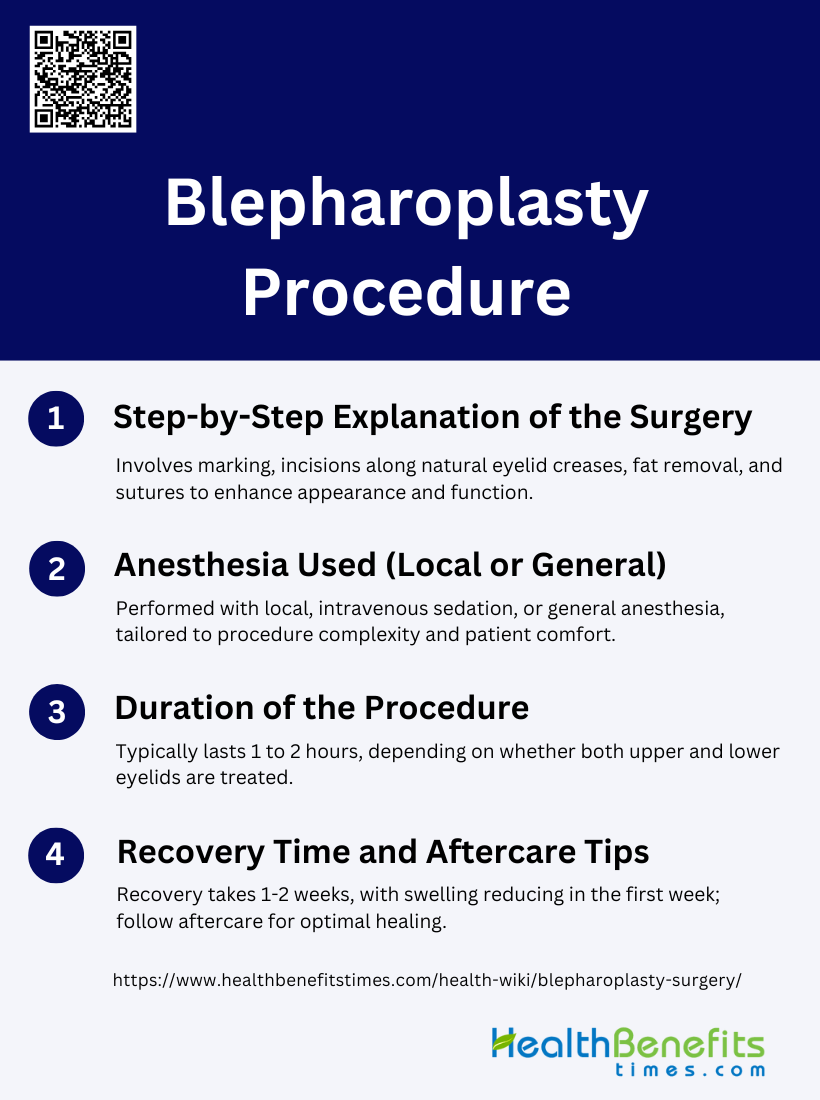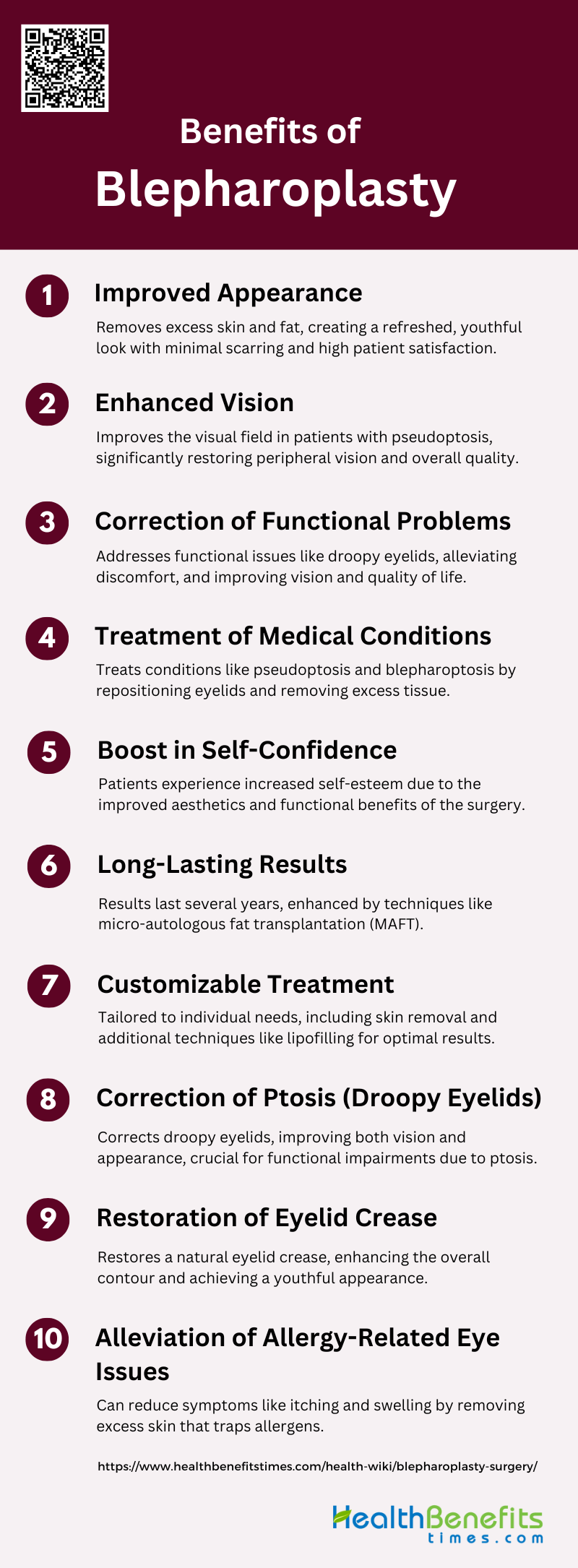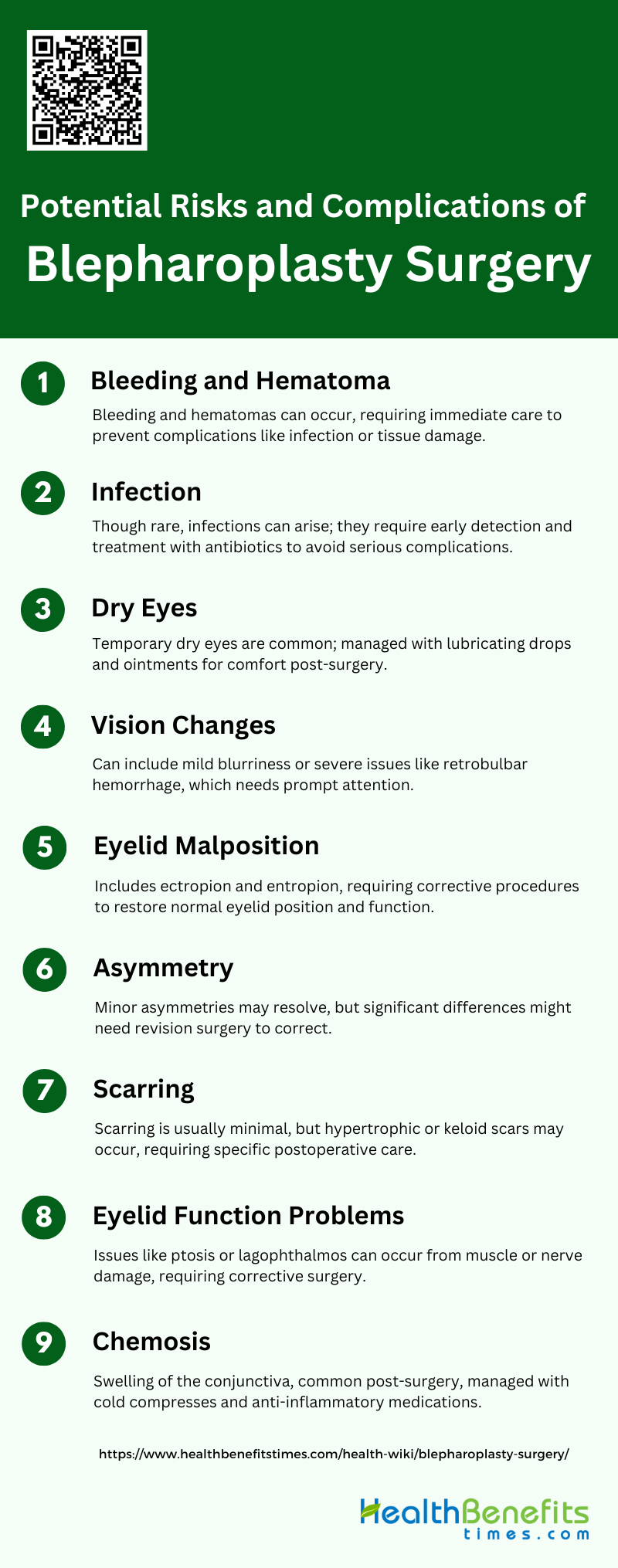Blepharoplasty, also known as eyelid surgery, is a cosmetic procedure aimed at rejuvenating the appearance of the upper and/or lower eyelids. This surgical technique involves modifying the shape and appearance of the eyelids by removing excess skin, muscle, and fat, although recent approaches have become more conservative in fat removal to prevent hollowing and maintain long-lasting results. Upper blepharoplasty is typically performed under local anesthesia and is considered a relatively simple operation, while lower blepharoplasty often requires general anesthesia. The procedure can address various aesthetic concerns, such as sagging skin, puffiness, and wrinkles around the eyes, ultimately enhancing the overall appearance of the periorbital area. It’s important to note that while blepharoplasty is primarily a cosmetic procedure, it may also have functional benefits for some patients, such as improving visual fields obstructed by excess upper eyelid skin.
Types of blepharoplasty
Blepharoplasty includes various procedures aimed at improving the appearance and function of the eyelids. These surgeries can address issues like drooping eyelids, under-eye bags, and the creation of a double eyelid crease. Below are the main types of blepharoplasty:
1. Upper Eyelid Surgery
Upper eyelid surgery, or upper blepharoplasty, is a prevalent cosmetic procedure aimed at enhancing the appearance of the upper eyelids. This surgery often involves the removal of excess skin, muscle, and sometimes fat to create a more youthful and alert appearance. In Asian populations, this procedure is particularly popular for creating a double eyelid crease, which can significantly alter the aesthetic of the eyes. Techniques vary, but a comprehensive approach that includes precise measurements and careful tissue handling can yield natural and aesthetically pleasing results with minimal complications. Additionally, upper blepharoplasty has been shown to improve functional outcomes such as visual field and quality of life, particularly in cases where droopy eyelids impair vision.
2. Lower Eyelid Surgery
Lower eyelid surgery, or lower blepharoplasty, addresses age-related changes such as bags, circles under the eyes, and a tired appearance. This procedure typically involves the removal or repositioning of excess skin and orbital fat to achieve a smoother, more youthful look. Various surgical techniques exist, and the choice of method depends on the specific needs and anatomy of the patient. While primarily performed for aesthetic reasons, lower blepharoplasty can significantly enhance the overall facial appearance. However, the most suitable surgical technique remains a topic of debate among surgeons, with considerations for preoperative planning, operative techniques, and potential complications being crucial for successful outcomes.
3. Double Eyelid Surgery
Double eyelid surgery, also known as Asian blepharoplasty, is a highly sought-after cosmetic procedure in East Asia. The goal is to create a visible crease in the upper eyelid, resulting in what is commonly referred to as a “double eyelid.” Techniques for this surgery include mini-incision blepharoplasty with pretarsal fasciectomy and full-incision methods with selective neurovascular preservation. These methods aim to provide a stable, natural-looking crease with minimal scarring and rapid recovery. High satisfaction rates have been reported, with patients experiencing quick resolution of swelling and long-lasting results. This procedure is particularly popular among individuals seeking a more defined and aesthetically pleasing eyelid appearance.
Who is a Good Candidate for Blepharoplasty
Blepharoplasty is suitable for individuals looking to enhance the appearance of their eyelids or address functional issues. Ideal candidates are generally healthy, non-smokers, and have realistic expectations about the outcomes. Below are the key criteria for determining a good candidate for blepharoplasty:
1. Individuals with Aging Changes: Candidates often include those experiencing aging-related changes such as redundant skin and fullness due to pseudoherniated fat.
2. Patients with Congenital Fullness: Those with congenital fullness of the eyelids, characterized by excess skin and muscle, can benefit from blepharoplasty.
3. Patients Seeking Aesthetic Improvement: Blepharoplasty is suitable for individuals looking to enhance their facial aesthetics, particularly those aiming to improve the appearance of tired eyes and achieve a more youthful look.
4. Individuals with Functional Impairments: Candidates include those with functional impairments such as reduced visual field, headaches, and vision-related quality of life issues due to droopy eyelids.
5. Patients with Realistic Expectations: It is crucial for candidates to have realistic expectations about the outcomes of the procedure. They should understand that while blepharoplasty can significantly improve the appearance of the eyelids, it may not address issues like fine wrinkling around the eyes or chronic eyelid edema.
6. Patients with Specific Anatomical Considerations: Those with specific anatomical features such as a deep upper orbital sulcus or orbitomalar sulcus abnormalities are good candidates, as these can be effectively addressed through blepharoplasty techniques.
7. Individuals with Periorbital Volume Loss: Candidates experiencing volume loss in the upper and lower eyelids and the malar area, which is a major component of periorbital aging, can benefit from augmentation techniques combined with blepharoplasty.
8. Patients with Functional Ptosis: Those with functional ptosis, characterized by symptoms such as superior visual field loss, down-gaze ptosis impairing reading, and discomfort due to droopy lids, are good candidates for blepharoplasty.
9. Patients with a Desire for Periorbital Rejuvenation: Individuals seeking periorbital rejuvenation to regain the softness and youthful appearance of their eyes through techniques like lipofilling and volume augmentation are suitable candidates.
10. Patients with Specific Surgical Goals: Candidates should have specific goals such as improving the tarsal platform show, addressing lateral hooding, or achieving a more defined eyelid crease, which can be effectively managed through tailored blepharoplasty techniques.
Blepharoplasty Procedure
Blepharoplasty involves several key steps to enhance the appearance and function of the eyelids. The procedure can vary based on the specific needs of the patient and the type of surgery being performed. Below are the main aspects of the blepharoplasty procedure:
1. Step-by-Step Explanation of the Surgery
Blepharoplasty involves several critical steps to achieve optimal results. The procedure begins with a thorough preoperative assessment, including marking the areas of excess skin and fat to be removed. For upper blepharoplasty, an incision is made along the natural crease of the eyelid, allowing for the removal of excess skin and sometimes muscle. Lower blepharoplasty can be performed through a transcutaneous or transconjunctival approach, focusing on the removal or repositioning of fat to address tear trough deformities and pseudoherniation of periorbital fat. The incisions are then closed with fine sutures to minimize scarring.
2. Anesthesia Used (Local or General)
Blepharoplasty can be performed under local anesthesia, intravenous sedation, or general anesthesia, depending on the complexity of the procedure and patient preference. Local anesthesia is often preferred for its safety and shorter recovery time, making it suitable for less extensive surgeries like upper blepharoplasty. However, for more complex procedures, such as lower blepharoplasty involving significant fat repositioning or removal, general anesthesia may be used to ensure patient comfort and optimal surgical conditions. The choice of anesthesia is tailored to each patient’s needs and the surgeon’s recommendations.
3. Duration of the Procedure
The duration of a blepharoplasty procedure varies depending on the extent of the surgery and whether both upper and lower eyelids are being treated. On average, the procedure takes about 1 to 2 hours. For instance, a three-step transcutaneous lower blepharoplasty with micro-autologous fat transplantation (MAFT) typically takes around 61 minutes. Upper blepharoplasty alone is generally quicker, often completed within an hour. The specific duration can vary based on the individual patient’s anatomy and the surgical techniques employed.
4. Recovery Time and Aftercare Tips
Recovery from blepharoplasty is relatively swift, with most patients returning to normal activities within 1 to 2 weeks. Initial swelling and bruising are common but usually subside within the first week. Patients are advised to keep their head elevated, apply cold compresses, and avoid strenuous activities to minimize swelling and promote healing. It’s crucial to follow the surgeon’s aftercare instructions, which may include using prescribed ointments and avoiding makeup until the incisions are fully healed. Regular follow-up appointments are essential to monitor the healing process and address any concerns promptly.
Benefits of Blepharoplasty
Blepharoplasty offers numerous advantages, ranging from aesthetic improvements to functional benefits. This versatile procedure can address a variety of issues, enhancing both appearance and quality of life. Below are the key benefits of undergoing blepharoplasty:
1. Improved Appearance
Blepharoplasty significantly enhances facial aesthetics by removing excess skin and fat, creating a more youthful and refreshed appearance. The procedure can improve the three-dimensional contouring of the eyes, making them appear brighter and more attractive. Patients generally report high satisfaction with the aesthetic outcomes, including improved tarsal platform show and minimal scarring.
2. Enhanced Vision
Upper blepharoplasty can significantly improve the visual field, particularly in patients with pseudoptosis. Studies have shown a marked increase in the superior visual field post-surgery, which enhances overall vision quality. This improvement is often quantified using visual field tests, demonstrating the procedure’s effectiveness in restoring peripheral vision.
3. Correction of Functional Problems
Blepharoplasty addresses functional issues such as droopy eyelids (ptosis) and dermatochalasis, which can impair vision and cause discomfort. The surgery improves margin reflex distance and alleviates symptoms like eye strain and headaches, thereby enhancing the quality of life. It also corrects asymmetries and compensatory mechanisms like brow elevation.
4. Treatment of Medical Conditions
Blepharoplasty is effective in treating medical conditions like pseudoptosis and blepharoptosis, which can obstruct the visual axis and cause functional impairments. The procedure can also alleviate symptoms related to these conditions, such as discomfort and eye strain, by repositioning the eyelids and removing excess tissue.
5. Boost in Self-Confidence
Patients often experience a significant boost in self-confidence following blepharoplasty due to the improved appearance and functional benefits. The procedure helps reveal inner beauty and attractiveness, contributing to a more positive self-image and greater satisfaction with one’s appearance.
6. Long-Lasting Results
Blepharoplasty offers long-lasting results, with many patients maintaining their improved appearance and functional benefits for several years post-surgery. Techniques like micro-autologous fat transplantation (MAFT) further enhance the durability of the results, ensuring sustained aesthetic and functional improvements.
7. Customizable Treatment
The procedure is highly customizable, allowing surgeons to tailor the approach based on individual patient needs. This includes decisions on the extent of skin and fat removal, as well as additional techniques like lipofilling for optimal contouring and rejuvenation. Customization ensures that both aesthetic and functional goals are met effectively.
8. Correction of Ptosis (Droopy Eyelids)
Blepharoplasty is particularly effective in correcting ptosis, which can significantly impair vision and appearance. The surgery lifts the droopy eyelids, improving both the visual field and the overall facial aesthetic. This correction is crucial for patients experiencing functional impairments due to ptosis.
9. Restoration of Eyelid Crease
The procedure restores a natural and aesthetically pleasing eyelid crease, which is essential for a youthful and attractive appearance. Techniques like precise skin excision and fat repositioning help achieve a durable and well-defined crease, enhancing the overall eye contour.
10. Alleviation of Allergy-Related Eye Issues
While not a primary indication, blepharoplasty can alleviate some allergy-related eye issues by removing excess skin that may trap allergens and cause irritation. The procedure can reduce symptoms like itching and swelling, contributing to overall eye comfort and health.
Cost of Blepharoplasty
The cost of blepharoplasty can vary widely based on several factors, including geographical location, the surgeon’s expertise, and facility fees. Additionally, insurance and financing options can impact the overall expense. Below are the main considerations for the cost of blepharoplasty:
1. Factors influencing the cost
The cost of blepharoplasty can vary significantly based on several factors. Geographical location plays a crucial role, with prices typically higher in major metropolitan areas and coastal regions compared to smaller cities or rural areas. The surgeon’s expertise and reputation also greatly impact the cost, as more experienced surgeons often charge premium rates for their services. Facility fees contribute to the overall expense, with procedures performed in hospitals generally costing more than those done in outpatient surgical centers. Additionally, the complexity of the surgery, whether it involves upper or lower eyelids or both, and any additional treatments required can affect the final price.
2. Insurance and financing options
While blepharoplasty is often considered a cosmetic procedure and not covered by insurance, there are instances where it may be deemed medically necessary and eligible for coverage. This typically occurs when excess eyelid skin obstructs vision, a condition that can be documented through visual field testing. For cosmetic cases, many practices offer financing options to make the procedure more accessible. These may include in-house payment plans, medical credit cards, or third-party financing companies specializing in elective medical procedures. Some surgeons also provide package deals or discounts for combining blepharoplasty with other facial rejuvenation treatments.
Recovery Process of blepharoplasty surgery
What to Expect During Recovery
The recovery process following blepharoplasty surgery typically spans several weeks. Initially, patients can expect swelling and bruising around the eyes, which generally peak within the first few days and gradually subside over the next two weeks. Discomfort is usually mild and can be managed with prescribed pain medications and cold compresses, although the latter may not significantly reduce swelling or bruising. It is crucial to avoid strenuous activities, heavy lifting, and bending over for at least two weeks to prevent increased blood flow to the eyes, which can exacerbate swelling and delay healing.
Tips for Faster Recovery
To expedite recovery after blepharoplasty, several strategies can be employed. Using cold compresses during the first 24-48 hours can help reduce discomfort, although their effect on swelling and bruising is minimal. Keeping the head elevated, even while sleeping, can significantly decrease swelling by promoting fluid drainage from the surgical site. Additionally, it is essential to avoid sun exposure, as UV rays can darken scars and prolong the healing process. Wearing sunglasses and applying sunscreen to the eyelids can provide necessary protection.
Long-term Care to Maintain Results
Long-term care following blepharoplasty is vital to maintain the surgical results. Patients should adhere to a skincare regimen that includes moisturizing and sun protection to preserve the delicate skin around the eyes. Regular follow-up appointments with the surgeon are essential to monitor healing and address any concerns promptly. Additionally, adopting a healthy lifestyle, including a balanced diet and avoiding smoking, can enhance skin health and prolong the rejuvenated appearance achieved through the surgery. Proper care and maintenance can ensure that the benefits of blepharoplasty are enjoyed for many years.
How to Choose the Right Surgeon for blepharoplasty surgery
1. Key factors to consider when selecting a blepharoplasty surgeon
When choosing a surgeon for blepharoplasty, it is crucial to consider their qualifications, experience, and reviews. A systematic review of the literature indicates that patients highly value a surgeon’s reputation and competency, often relying on word-of-mouth and physician referrals to make their decision. Additionally, the surgeon’s interpersonal skills and the quality of information available about their practice play significant roles in patient choice. Ensuring that the surgeon is board-certified and has extensive experience in performing blepharoplasty can provide added assurance of their expertise and reliability.
2. Importance of a Consultation to Discuss Expectations and Any Concerns
A consultation is a vital step in the decision-making process for blepharoplasty. It allows patients to discuss their expectations and any concerns they may have directly with the surgeon. Although a study found that consultation time was not significantly associated with the decision to undergo blepharoplasty, the presence of eyelid deformity or disease was a significant factor. This highlights the importance of a thorough consultation to address specific medical conditions and aesthetic goals. During this time, patients can assess the surgeon’s communication skills and ensure that their expectations align with the proposed surgical plan, ultimately leading to a more satisfactory outcome.
Potential Risks and Complications of blepharoplasty surgery
Blepharoplasty carries potential risks and complications that patients should be aware of before undergoing the surgery. Understanding these risks can help in making an informed decision and preparing for any possible outcomes. Below are the key risks and complications associated with blepharoplasty:
1. Bleeding and Hematoma
Bleeding and hematoma are common complications following blepharoplasty. Hematomas can form due to the rupture of small blood vessels during surgery, leading to blood accumulation under the skin. This can cause swelling, bruising, and discomfort. Immediate postoperative care involves monitoring for signs of excessive bleeding and applying cold compresses to reduce swelling. In severe cases, surgical intervention may be required to drain the hematoma and prevent further complications such as infection or tissue necrosis.
2. Infection
Infections, although relatively rare, can occur after blepharoplasty. They typically present with redness, swelling, pain, and sometimes discharge from the surgical site. Preventive measures include maintaining a sterile surgical environment and prescribing prophylactic antibiotics. Early detection and treatment with appropriate antibiotics are crucial to prevent the spread of infection and more severe complications such as orbital cellulitis.
3. Dry Eyes
Dry eyes are a frequent minor complication of blepharoplasty, often resulting from disruption of the tear film or temporary lagophthalmos. Symptoms include irritation, a gritty sensation, and increased tear production. Management involves the use of lubricating eye drops and ointments to maintain moisture on the ocular surface. Patients with pre-existing dry eye conditions should be identified preoperatively to mitigate the risk of exacerbation post-surgery.
4. Vision Changes
Vision changes post-blepharoplasty can range from mild blurriness to severe complications like retrobulbar hemorrhage, which can lead to blindness if not promptly addressed. Corneal abrasions and temporary diplopia are also possible. These complications necessitate immediate medical attention to prevent permanent damage. Preoperative assessment and careful surgical technique are essential to minimize these risks.
5. Eyelid Malposition
Eyelid malposition, including ectropion and entropion, can occur due to excessive skin removal or improper surgical technique. This can lead to functional and aesthetic issues, such as difficulty closing the eyes and exposure keratitis. Corrective procedures may be required to restore proper eyelid position and function. Preoperative evaluation of eyelid laxity and careful surgical planning are crucial to prevent these complications.
6. Asymmetry
Asymmetry is a potential outcome of blepharoplasty, where one eyelid may appear different from the other in terms of shape, size, or position. This can result from uneven tissue removal or healing processes. While minor asymmetries may resolve over time, significant discrepancies might necessitate revision surgery. Surgeons should aim for meticulous symmetry during the procedure and manage patient expectations regarding natural variations.
7. Scarring
Scarring is an inevitable part of any surgical procedure, including blepharoplasty. While most scars are minimal and fade over time, hypertrophic or keloid scars can occur, leading to aesthetic concerns. Proper surgical technique, including precise incision placement and gentle tissue handling, can minimize scarring. Postoperative care, such as the use of silicone gel or sheets, can also help improve scar appearance.
8. Eyelid Function Problems
Eyelid function problems, such as ptosis or lagophthalmos, can arise from blepharoplasty. These issues may result from muscle or nerve damage during surgery. Ptosis presents as drooping of the upper eyelid, while lagophthalmos is the inability to fully close the eyelids. Both conditions can lead to ocular surface exposure and discomfort. Surgical correction may be necessary to restore normal eyelid function and protect the eye.
9. Chemosis
Chemosis, or swelling of the conjunctiva, is a common postoperative issue following blepharoplasty. It can result from surgical trauma, excessive tissue manipulation, or pre-existing conditions like eyelid laxity. Symptoms include a swollen, gelatinous appearance of the conjunctiva, which can cause discomfort and visual disturbances. Management includes the use of cold compresses, anti-inflammatory medications, and in some cases, surgical intervention to alleviate the swelling.
FAQs
1. Can blepharoplasty be combined with other cosmetic procedures?
Yes, blepharoplasty is often combined with other procedures such as a brow lift, facelift, or laser resurfacing to achieve a more comprehensive facial rejuvenation. Consult your surgeon to determine which combination of treatments is appropriate for your goals.
2. Will I have visible scars after blepharoplasty?
In most cases, the incisions are made in natural folds of the skin (like the crease of the upper eyelid or just below the lash line for the lower eyelid), making scars minimally visible. Over time, the scars typically fade and become almost imperceptible.
3. Is blepharoplasty reversible?
Blepharoplasty results are generally permanent, but in cases where complications or dissatisfaction with the results occur, revision surgery may be performed to correct issues. However, complete reversibility is not guaranteed.
4. Can I wear contact lenses after blepharoplasty?
Patients are usually advised to avoid wearing contact lenses for at least two weeks post-surgery. Your surgeon will give specific instructions on when it is safe to resume using them.
5. Will blepharoplasty affect the shape of my eyes?
The goal of blepharoplasty is to enhance the appearance of the eyelids without significantly altering the natural shape of your eyes. However, minor changes in the appearance and contours may occur, especially with lower eyelid surgery.
6. Is there a non-surgical alternative to blepharoplasty?
For patients seeking less invasive options, non-surgical alternatives such as laser treatments, radiofrequency, or injectable fillers may temporarily reduce the appearance of eye bags or sagging skin, though they will not provide the long-lasting results of surgery.
7. What happens if I don’t like the results of my blepharoplasty?
In cases where patients are dissatisfied with the outcome, revision blepharoplasty can be performed to adjust the results. However, it is important to wait until the healing process is complete before considering any corrective surgery.
8. Can blepharoplasty help with headaches caused by droopy eyelids?
Yes, in some cases, droopy eyelids can contribute to tension headaches due to the extra effort required to keep the eyes open. By removing excess eyelid skin, blepharoplasty may relieve this type of headache.
9. How long will the results of blepharoplasty last?
Results from blepharoplasty can last for many years, and in some cases, the improvements are permanent. However, aging continues, and skin may gradually lose elasticity over time, which might eventually lead to further sagging.
10. Can blepharoplasty fix asymmetrical eyelids?
Yes, blepharoplasty can address eyelid asymmetry, especially if one eyelid sags more than the other. The procedure can balance the appearance of both eyelids, but achieving perfect symmetry is not always guaranteed.





